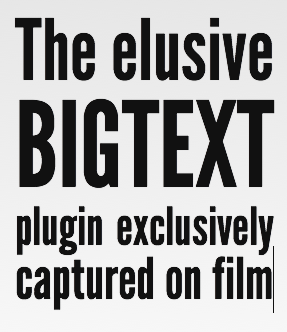It all began with a simple web foray to Designing Monsters. Their simple, typographic design was beautiful. But why? Their combination of the beautiful League Gothic font, use of Lettering.JS, and some simple font scaling gave the page a wonderful consistent vertical alignment. Like the Million Dollar Homepage, I wanted to rebuild it — but I didn’t want to spend a lot of time manually adjusting font sizes. So I did what any programmer with the jQuery Golden Hammer would do, I turned my problem into a nail.

At it’s simplest, the BigText jQuery plugin takes a single element and sizes the text inside of its child
s to fit the width of the parent element. Gives the text that lovely vertical alignment.
The elusiveBIGTEXTplugin exclusivelycaptured on film$('#bigtext').bigtext();Implementation Details
The plugin itself is more than just a simple font-size incrementer. I wasn’t happy with the performance of simply iterating through font sizes with a single fixed interval. I decided it would be better to test multiple decreasing intervals. For each line, it increments first by 16em until it detects a line break, backs off an interval then increments by
8em. It continues with 4em, 2em, 1em, 0.1em, until it finds the correct font-size to the nearest hundredth of an em. It’s noteworthy that Webkit does not respect font-sizes to the nearest hundredth, it’s precision is maxed out at tenths. This algorithm results in fewer tests in most cases, especially where the resulting font-size will be very large. Performance is always important. After font-size, it moves to word-spacing as a backup for extra precision, especially needed on Webkit.The BigText Demo Wizard
Check out the Demo
This is where the magic happens.
- Editable text (
contenteditable), and BigText will run on every keyup event to resize what you’re typing. - Dynamic horizontal and vertical centering using Alex Russell’s Flex Box CSS classes (This is easy now, hooray!)
- 3D transforms (browser support checked using Modernizr, currently only available in Safari. Note: Chrome flattens to 2D space)
- Custom fonts are loaded using Google’s Font Loader JavaScript API
- Ben Alman’s Throttle Plugin
- The rest is mostly jQuery UI with the Aristo theme
Turns out, the BigText Demo Wizard makes for really easy Kinetic Typography screencasts (not amazing, but surely easy):
<br />
The above is simply the manual process of typing lyrics into the BigText Demo Wizard. You can easily make one of these too, with the help of the following keyboard shortcuts:
- CTRL + ALT + X: Set the text to a random 3D transform angle.
- CTRL + ALT + C: Toggles between white and black background.
- CTRL + ALT + R: Reset 3D to default state.
- CTRL + ALT + SPACE: Fade out current text, clears the text, sets a random 3D transform angle, ready to type!
- CTRL + ALT + ENTER: Same as CTRL + ALT + SPACE, but keeps the same 3D transform angle.
The fun part about the BigText Demo Wizard for me was that it almost turned into a non-musical instrument when I used it real-time to complement music. Feel free to cruise Pandora and type lyrics to the music until your wrists get sore. What can you make with it?
The BigText Demo Wizard was tested manually in Safari 5, Chrome 8, Opera 11, Firefox 3.6, and Internet Explorer 8. The BigText jQuery plugin has a full JsTestDriver suite, available on GitHub. Just run
./test.sh or test.bat
Comments
Post a Comment